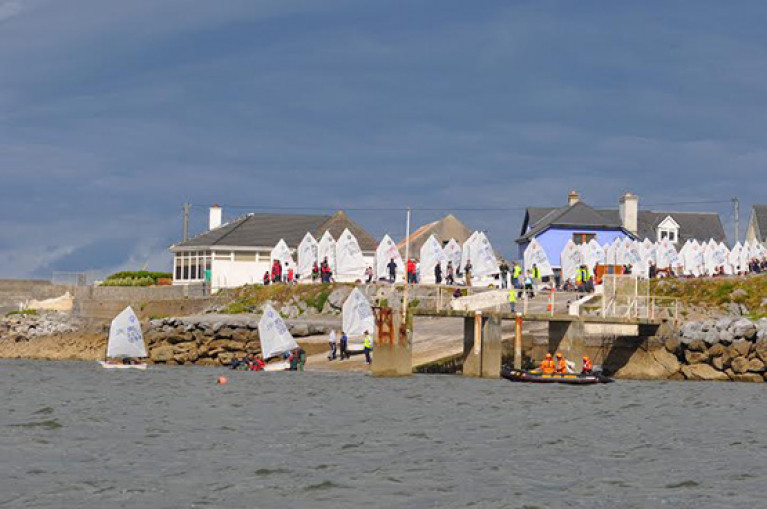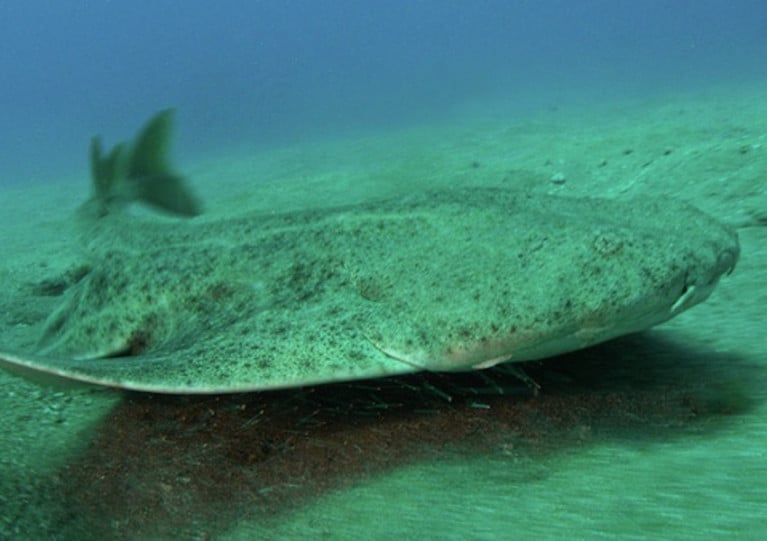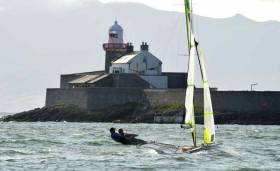Displaying items by tag: Tralee Bay
New Footage of 1970 Fireball Worlds in Fenit Emerges Online
Film footage of the 1970 Fireball World Championship hosted in Fenit by Tralee Bay Sailing Club has been digitised after more than 50 years and has been shared online by John Caig, who won the event with Jack Davies.
According to Caig, the original 16mm film had deteriorated over the decades but a BBC engineer was able to transfer the footage to digital at a higher resolution than existing colour video of the event.
Barry O’Neill of the Royal St George Yacht Club provided Afloat.ie with more details about the film, which was made on “zero budget” by O’Neill and colleagues from the former Arks advertising agency.
Members of the Celtic rock band Horslips also worked at the agency at the time, and O’Neill says he roped them in to compose music for the film, which may mark “one of the first times Horslips had been in a recording studio”.
Data Buoy Deployment for Fenit Harbour Dredge Monitoring
LCF Marine have planned to deploy two data buoys in Tralee Bay this week as part of dredge monitoring for Fenit Harbour.
The buoys were scheduled to be deployed on Monday 23 January subject to weather and operational constraints.
If the deployment is delayed due to the weather, the deployment will be carried out on the next viable tide and weather window.
The buoys will be in place for 10 weeks at the coordinates indicated in Marine Notice No 3 of 2023, which is attached below.
These data buoys will be deployed on a single point mooring consisting of 19mm diameter chain and a on-tonne sinker weight.
A lantern on each buoy will give out five yellow flashes every 20 seconds. The light is visible for up to three nautical miles.
The data buoys are yellow in colour and each buoy is equipped with a navigational beacon, radar reflector, St Andrew’s cross, GSM antennas, solar panels, lead batteries, instrument cables and a TechWorks Marine Black Box.
Works vessel An tOileanach (callsign EI-5930) has been employed to deploy the buoys. During the deployment and recovery, radio transmissions will be conducted on VHF channels and will be monitored on Channel 14 (Fenit Harbour working channel) and Channel 16.
During operations the work vessel will be restricted in its ability to manoeuvre, and all other vessels are requested to leave a wide berth during the deployment operations.
Kerry County Council approached McWilliam Sailmakers in Crosshaven to build and design new windmill sails for the Blennerville Windmill on Tralee Bay.
Restoration works on the windmill have already seen new wing frames built by Cedarlan Ltd, which has its own sailing connections through director Martin Lane who sails out of Schull with his Oceanis 331, Chatterbox.
The new windmill sails are 16 square metres each, made from Tanbark Dacron cloth and specially designed to fit the new wings.
 A closer view of one of the Tanbark Dacron cloth sail — note the twist towards the inside of the wing
A closer view of one of the Tanbark Dacron cloth sail — note the twist towards the inside of the wing
Each sail is designed to be hoisted and dropped independently from the deck without going aloft, which is safer and quicker to do.
This commission has been a very specific project in how the sails will be used.
They are left on the wings resting against the whip (mast) of the wing, rolled up. And when they are out fully working, you need to use each opposite side to balance the windmill when opening and closing.
 The windmill with reefed sails, with Barry Hayes of McWilliam Sailmakers beneath
The windmill with reefed sails, with Barry Hayes of McWilliam Sailmakers beneath
You can also reef each sail for specific wind conditions, taking one, two or three reefs in each sail or just having two sails out if get to 15 knots. Again you can reef these last two sails down as well depending on the wind you want the windmill working in.
The windmill has a brake which allows you to stop each wing at deck level when you want to work on each sail.
All in all, it's been a highly interesting technical project for the Cork Harbour sailmakers, learning something very different in how working sails are used on a windmill.
TechWorks Marine has scheduled the deployment of three trawl-resistant acoustic Doppler current profilers (ADCPs) in Tralee Bay from next week.
The three bottom-mounted ADCP frames will be positioned on the seabed at various depths between Monday 1 and Saturday 13 November, weather depending.
If the deployment is delayed due to unsuitable conditions, then it will be carried out on the next viable tide and weather window.
Once deployed, the frames will be on the seabed for a minimum of one calendar month and a maximum of two months, weather permitting.
 Map showing the planned ADCP locations in Tralee Bay | Credit: TechWorks Marine
Map showing the planned ADCP locations in Tralee Bay | Credit: TechWorks Marine
They are required to carry out water quality sampling surveys and vessel-mounted ADCP surveys at the same time as the deployments. As these are tide and weather dependent, they may cause a slight delay in the recovery of the seabed frames.
The frames will be deployed by the Whispering Hope (callsign EIAR8) which will be restricted in its ability to manoeuvre during this operation.
Vessels operating within this area are requested to keep their distance, maintaining a safety zone around the deployment vessel, and pass at minimum speed to reduce vessel wash.
Details of the exact locations of the ADCP frames and other information for mariners can be found in Marine Notice No 59 of 2021, which can be downloaded below.
Tribal's Light Air Masterclass Claims WIORA Title at Tralee Bay
The Bon Secours WIORA West Coast Championship was held in Tralee Bay Sailing Club from Aug 25-28 with light breezes and glorious sunshine on three days out of four.
PRO John Leech did an amazing job to get nine races in for all three fleets. He even managed one on Friday despite poor visibility and fickle winds.
IRC 1 was a masterclass in light air sailing from the Farr 31 Tribal from GBSC with Liam Burke at the helm. She won 7 races to easily take the class win. Jaguar (Gary Fort) a J92s from the host club was second with Dexterity an X332 from FYC (Team Foynes) in third.
Tribal also did the business in ECHO 1 but here it was Ibaraki (Mike Guilfoyle) from GBSC in second with Jaguar in third.
IRC was a real ding dong battle between the J 24s from Foynes and a Corby 25 from TBSC. All three won races but at the finish, it was Lady J (Ray McGibney) from FYC who took the trophy. David Buckley’s Eclipse from TBSC was a close second with Darragh McCormack of FYC on Stouche in third. In ECHO 2 LadyJ was also the winner. Eclipse and Stouche swapped places here.
The white sails fleet enjoyed very close racing. Samphire (Mary O’Sullivan) from TBSC was the early leader but Seasmoke (Kevin Reidy) FYC took matters into his own hands on day two with two bullets and a second in the three races. Going into the last day it was very tight with the all-important second discard likely to come into play. Bev Lowes on Poitin from FYC took both races to win by one point from Samphire with Seasmoke on the same total taking third.
 Liam Burke sailing the Farr 31 "TRIBAL" and his young crew from Galway Sailing Club won 7 races out of 9 races to win his class at WIORA. Tribal also won under ECHO 1. Photo from left to right -David Carbery, Cormac Conneely, Justin Mitchel Ward, Jack Nolan, Liam Burke (Skipper) Ronan Shepard and Olivia Cure.
Liam Burke sailing the Farr 31 "TRIBAL" and his young crew from Galway Sailing Club won 7 races out of 9 races to win his class at WIORA. Tribal also won under ECHO 1. Photo from left to right -David Carbery, Cormac Conneely, Justin Mitchel Ward, Jack Nolan, Liam Burke (Skipper) Ronan Shepard and Olivia Cure.
WIORA now looks forward to next year’s event to be held on the Shannon Estuary under the burgee of the Royal Western Yacht Club in Kilrush.
Full results available here
Data Buoys for Oceanographic Monitoring of Fenit Harbour Set to Deploy in Tralee Bay
TechWorks Marine advises that it is set to deploy two marine monitoring buoys in Tralee Bay as part of environmental oceanographic monitoring for Fenit Harbour.
The DB 500 data buoys will be deployed tomorrow, Friday 26 March, weather depending, and will be in place until at least Friday 30 April, after which they will be retrieved by a chartered vessel.
A flat-bottomed aqua-cultural work barge named the Kerry Pearl will be deploying the buoys. During deployment and recovery, VHF Channels monitored will be Channel 14 (Fenit Harbour working channel) and Channel 16.
During the extent of deployment, vessel traffic will need to avoid the area.
Full details including exact location coordinates are included in Marine Notice No 14 of 2021, which can be downloaded below.
WIORA Championships at Tralee Bay is Cancelled Due to COVID-19
Tralee Bay Sailing Club (TBSC) in Fenit, County Kerry and WIORA have jointly announced that the WIORA Championships scheduled for September at the most westerly port in Europe have been cancelled.
TBSC Commodore Liam Lynch told Afloat 'With the current coronavirus restrictions and the likelihood of further outbreaks, the club and organisation agreed that it would be impossible to stage the event to the standard expected'.
Tralee Bay is a “major nursery” for sharks and rays in Irish waters, says a local marine wildlife expert.
And Kevin Flannery insists the important breeding ground for the likes of angel sharks and porbeagle sharks needs protection.
Marine biologist Flannery, of Dingle OceanWorld, described the little-known nursery off the Kerry coast as “a Serengeti of the Atlantic for rays and sharks”.
And as National Biodiversity Week begins, he’s calling for Tralee Bay to be designated as a marine protected area to provide a safe haven for the many species that lay their eggs there in summer months.
The Irish Mirror has more on the story HERE.
Dolphin Encounter In Tralee Bay Too Close For Comfort
O’Sullivan’s Marine have shared with us a photo of the surprise moment when a dolphin landed on the bow of one of their boats.
The sudden encounter was all the more startling as the marine mammal almost knocked a child out of the boat — but the youngster still managed to capture the cetacean on camera.
Elsewhere, BreakingNews.ie reports that a striped dolphin was found dead in a river near Lahinch despite the best efforts of local surfers after the animal live-stranded on the popular North Clare beach.
Dr Simon Berrow of the Irish Whale and Dolphin Group, who also joined the rescue effort, said: “We found a striped dolphin, quite a large animal, obviously in distress. We tried to push it out again [to sea] but it was very weak.”
The IWDG chief added: “The surfers did their best and we thank them for trying but sometimes a dolphin will live strand themselves … there’s very little you can do.”
Olympic 49er Hopefuls Put on a Show in Tralee Bay
Tralee Bay in County Kerry was the perfect arena for a high–paced weekend of sailing. Led by the Tralee Bay Maritime Centre with the support of Tralee Bay Sailing Club, 49er Olympic hopefuls gave an incredible ballet of spinnakers over three days.
The primary event was the return of the 49er national championships but the added benefit was that local dinghy sailors could see Irish Olympic sailors at first hand. With the addition of John Chambers Waszp design, the event was a great conclusion of the summer season.
On the racing front, four races were completed on Friday afternoon in 10-12kts from the south west on the west side of Fenit Marina. The start line was just a few boat lengths away from the Marina bridge making it very spectators friendly. Indeed, one of the aims of the weekend was to bring the sailing as close as possible to the public as opportunities to actually see top sailors in action at home is rare enough.
With four different race winners, it was tight racing and Matt McGovern and crew Robbie Gilmore headed back ashore with a narrow lead over the rest of the field.
 Northern Ireland duo Robbie Gilmore (left), regatta organiser Thomas Chaix and Matt McGovern with the 49er National Championships trophy
Northern Ireland duo Robbie Gilmore (left), regatta organiser Thomas Chaix and Matt McGovern with the 49er National Championships trophy
Saturday saw the passage of a very active front, and despite a progressive drop of the strong winds, racing was definitely abandoned at 16.30.
Sunday gave the sailors some great sailing conditions with 8-12kts from the south west. This time the course was located to the East of the Marina with the windward touching distance from the Marina walls. The U–23 European bronze medallists Cian Byrne and Paddy Crosbie were on form with three second position and ended their challenge with a race win but Matt and Robbie’s consistency was enough to secure the title.
Overall top 3
1st Matt McGovern – Robbie Gilmore, BYC, 1-2-2-2-3-1-1-3
2nd Cian Byrne – Paddy Crosbie, RCYC, 4-4-1-4-2-2-2-1
3rd Robert Dickson – Sean Waddilove, HYC, 3-3-3-1-1-3-3-2
The weekend was not all about racing and the sailors returned the warm welcome given by locals by taking kids sailing and giving crewing experience to local sailors. John Chambers Waszp was also a great addition to the weekend. TBMC principle Brian O’Sullivan and organiser Thomas Chaix were delighted with the outcome and are definitely looking forward to welcoming the 49ers again.





























































